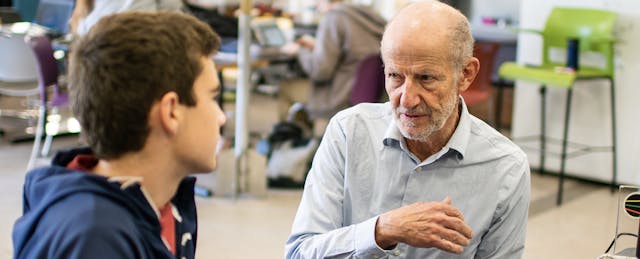The varied stints throughout Larry Rosenstock’s career reflect the ethos that he instills in students at High Tech High, the San Diego public charter school network he helped found in 2000 that espouses an experiential approach to education.
As a carpenter, he learned how to work hard—and that he loves working with kids. Assisting at a psychiatric hospital, he came to understand that every person learns and thinks differently. As a lawyer, he helped draft a bill that would advance educational opportunities for students from all backgrounds.
Each stop offered life experiences that would shape his work at High Tech High, where Rosenstock serves as CEO. And all those connections came into relief during the gathering of the 2019 World Innovation Summit for Education (WISE), which drew 3,000 people from 110 countries last month to Doha, Qatar.
During the event, Rosenstock was recognized for his “lifelong dedication to rethinking K-12 learning and tackling inequality through education” and subsequently awarded the WISE Prize for Education—the first-ever American recipient. The prize was established in 2011 by Sheikha Moza bint Nasser, of the Qatari royal family, to recognize individuals’ outstanding contributions to education. It provides recipients with $500,000 to enhance their existing work or launch a new project, and is intended to laud lifetime achievements in education the way that other international prizes honor exceptional work in literature, peace and economics.

Nearly 20 years since its founding, Rosenstock still leads High Tech High, which today comprises a network of 16 public charter schools, a teacher credentialing program, and a graduate school of education that he says is one of only two master’s programs in the country embedded in K-12 schools. (The other is Bank Street, in New York.) High Tech High pairs traditional academics with vocational training, and places great emphasis on project-based learning.
With his prize money, Rosenstock plans to establish a digital collection of art and other creations made by students across the globe. The idea, he says, is that the work showcased will help inspire students and teachers alike—and give educators a starting point for different projects to pursue with their own pupils.
After receiving the WISE Prize in Doha, Rosenstock sat down with EdSurge to discuss the early days of his career—and the serendipitous series of events that led him to education and where he is today. The interview has been condensed and edited for clarity.
EdSurge: Your path to education is an interesting one. Could you share how you got into this work, going back to the beginning?
Rosenstock: Back in the 1970s, on the East Coast, they made settlement houses for low-income people. And there’s an old settlement house in Cambridge, Mass., that has multi-floors, and I was asked to make a place upstairs in the attic where they could process photographs or films.
So I was working on that, and it’s all carpentry, which I did when I was very, very young right after college. I did a lot of carpentry. I still love it to this day. I was up there in that top floor of the settlement house working, and there were inner city kids that came in every week day to play basketball and just go bananas downstairs, running around. And they heard noises coming from the top floor. They were attracted to it; they started coming upstairs to where I was working. They started asking what I was doing. I started explaining it to them, showing them how to use tools. And it didn’t bother me. It was really kind of fun.
And then, after a few days, I realized something. I was looking forward to 3 o’clock, subconsciously; that’s when the kids would come. I realized I really liked when they came up. And the guy who ran the settlement house said to me one day when I was putting away my tools: “You know, I’ve been watching you. You should be working with kids.”
When I went home that night, I was brushing my teeth and I looked at myself in the mirror, and I said to myself, “Is he right?” And I realized he was.
From there, I applied for a job at Harvard Psychiatric Hospital. There was a carpentry room, a music room, an art room, and other things for patients at that hospital. The head of the agency said, “I’m going to take a chance on you,” and she hired me. But that was not the demographic that I really wanted to work with.
Still, a few things happened. Number one, they were making things, and projects. Some of them were really, really quite beautiful. I really enjoyed working with them, but I also felt that I didn’t want to work with adults in mental hospitals. I really wanted to work with kids.
So I got a license to be a teacher in Boston, and I got hired. And then I went over to Cambridge after three years. So that’s how I got started.
In those early years working at the settlement house and the psychiatric hospital, what did you learn about young people, or about how individuals learn?
What I learned is that we all learn differently. And, yeah, people in mental hospitals learn differently depending on what their diagnosis is. But the same thing is true in terms of young kids. I’m thinking even back to when I was in the Cambridge Public Schools as a carpentry teacher.
A lot of your background is teaching at and learning from prestigious institutions like Brandeis and Harvard. How did that form your experiences working with students from all different backgrounds?
Brandeis was fascinating for me because I was a psychology major. And I spent four years with Abe Maslow, [the psychologist who created Maslow’s Hierarchy of Needs and established the theory of self-actualization].
His Hierarchy makes complete sense and is active today. What’s a human looking for most? If they’ve got nothing, they’re looking for food, clothing, shelter. If they are lucky [and those basic needs are met], they’re looking for self-actualization. And actualization he defined as some sort of arrival where you’re a centered human being.
I drove Abe home from the university a lot in my funky little car. I got really close to him, and I remember the last time I saw him before he passed away, he said, “Larry, I’m happy, happy happy,” and he was—very, very happy. So he had an influence on me really greatly and in recognizing that what we’re all trying to do as human beings is to find our niche, essentially.

Most people know you for your work at High Tech High. Could you share where that idea came from and how you got involved?
There was a group effort, supported through a big grant from the Clinton administration when I was in Cambridge, called The New American High School. The whole idea was that there would be a new design for the American high school, and so we got the grant and we ran around the country looking for great schools. Some of them were disappointing and some of them were absolutely fantastic.
And the one that was most fantastic was one that we found in San Diego, very close to the border of Mexico. I was mesmerized by what I saw, and by the level of discourse I observed in the students there. My colleague Rob Rearden and I walked outside on the landing of the school—and we've been driving around for years trying to find stuff, funding this big grant—and we just stood there looking at each other, as if to say, “We just found it.”
So we moved to San Diego, and the teacher who was behind what I saw, he was just fussing with his papers in the corner as if he had nothing to do with it. Because that’s what he’s like as a personality, he doesn't want any of the credit. But it was all about him. He was just fantastic—a fantastic teacher.
So we decided to go there and look deeper, and then someone offered me a job to start a new school called High Tech High School. And I said “Yes, except for one thing.” And he said “What’s that?” I said, “Can we take the name ‘School’ off of it and just call it High Tech High?” And he said yes. It’s a ridiculous name, High Tech High, but I still like it.


